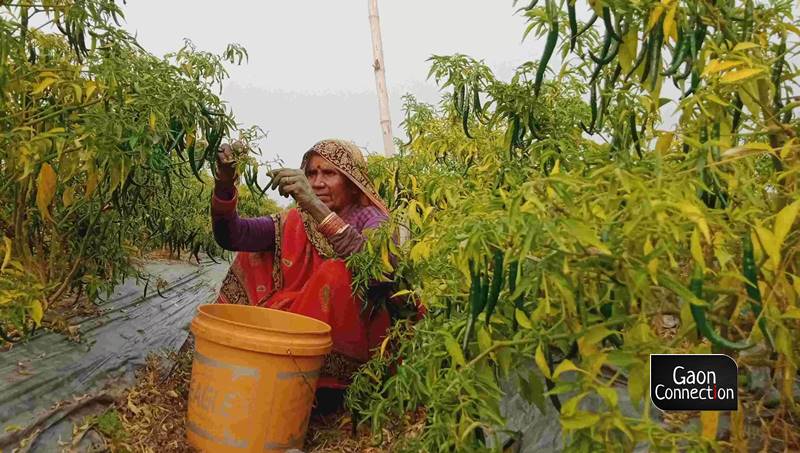Migrant labourer returns to his village; reaps profit by employing modern farming techniques
Once a debt-ridden family of daily wage migrant labourers, Suresh Prajapati’s household is now reaping profits by cultivating vegetables in the water -scarce Bundelkhand region of Uttar Pradesh by using modern techniques. Details here.

Lalitpur, Uttar Pradesh
About ten years back, it was impossible for 35-year-old Suresh Prajapati to think of increasing his income by working as a daily wage labourer in Delhi and paying off his debts but ever since he came back to his village and began to cultivate fields his life is none like before.
“I have cleared all my loans and my family is leading a respectable life now. We are not labourers anymore and are in control of our kismat (destiny),” Prajapati, a resident of Khiriya village in Mahroni block of Uttar Pradesh’s Lalitpur district told Gaon Connection.
Lalitpur district, which is situated almost 400 kilometres from state capital Lucknow is part of the Bundelkhand region which is known for its water scarcity. However, modern farming techniques used by the Prajapati have helped him in reaping profitable produce.
Also Read: Rabi cultivation in Lalitpur takes a hit as farmers complain of fertiliser shortage

But even farming wasn’t profitable for him in the beginning.
“Earlier I used to cultivate crops like wheat, gram, peas and masoor (pink lentils) but they failed badly and I was distressed due to continuous crop failures. A relative advised me to grow tomatoes using techniques like mulching and drip irrigation. It has helped me immensely,” he said.
Drip irrigation and mulching changed the game
The water-scarce region of Bundelkhand often results in crop failure for the farmers. This leads to rural distress in the region as farmers avail loans to survive which they often fail to pay back.
“Drip irrigation has actually helped me in reducing the dependence on rains and we need less water for our crops,” Prajapati said.
“We have also benefited greatly from mulching which involves covering the soil with a polythene sheet to protect its fertility. Also, stacking which means growing vegetables in stacks increases their quality and yield,” he added.

As per the Union Ministry of Agriculture, drip irrigation reduces water requirement of farmers by 70 per cent and it provides subsidies upto 90 per cent for farmers who are interested in setting it up. In November this drip irrigation subsidy scheme was extended to 2026. Although installing drip irrigation system costs farmers an additional expense, its long term benefits outweigh the input cost.
Prajapati told Gaon Connection that installation of drip irrigation system cost him Rs 25,000 and mulching has cost him Rs 15,000.
Profits upto Rs 400,000 in an acre
An acre (about half an hectare) of land requires about Rs 100,000 of investment. This includes Prajapati’s costs of insecticides, manual labour, crop protection among other expenses.
Also Read: Healthy Returns: Vegetable and fruit cultivation picks up momentum in India
But the profits reaped are four times the input cost.
“I presently cultivate vegetables like brinjals, tomatoes, and chillies on two acres (about an hectare) of land. I will easily earn profits worth rupees six lakhs. That much is certain. If things go well, I am hoping to earn almost eight lakh rupees this season,” he said.

“All this wasn’t possible by using traditional farming methods. I also grow bitter gourd, pumpkin and bottle gourd in the rainy season.
Talking about the miseries of the earlier days, Prajapati’s mother Terabai told Gaon Connection that traditional methods of farming did not provide any respite from the hardships.
“It was only after we set up borewells that things began to change. Luckily, we got the water from the borewells and began to cultivate vegetables. Now, we can save some money as well. Earlier all the money we earned went in paying loans and just managing to eat twice a day,” the 55-year-old told Gaon Connection.
Also Read: Debt and natural calamity push Bundelkhand’s farmers to the brink
Also, Ramcharan Prajapati (45), Suresh’s cousin brother said that they earned little while working as daily wage labourers in Delhi.
“Now we have no debt and are able to get our children educated,” he added.

